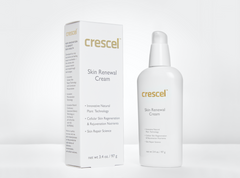Abstract: Clinical Study to Assess the Therapeutic Efficacy of a Novel Anti-Inflammatory Facial Moisturizer in Rosacea
Introduction
Rosacea—a highly inflammatory skin condition that primarily affects the face—is chronic, recurrent, progressively disfiguring and painful, and driven by a complex interplay of vascular, neural, and immune mechanisms. Patients experience significant physical, emotional, and psychosocial burdens. This high-impact dermatosis affects 5% of the world’s population (primarily women between 25 and 65 years of age), which translates to at least 1 in every 10 people in the U.S. and at least 415 million globally.
The range of symptoms includes prominent redness and flushing, acne-like papules (hard lumps) and pustules (hard pus-containing lumps), highly visible enlarged blood vessel clusters, pronounced dryness, and unpleasant sensations (pain, stinging, burning, and tingling). In addition, the uniquely overreactive facial skin of rosacea patients is extremely vulnerable to flushing/blushing/dryness and/or a number of neurosensory issues from a spectrum of sources: environmental, internal, dietary, and topical (including skincare products, cosmetics, and rosacea treatments themselves). To complicate matters further, beyond these basic characteristics, rosacea is not a straightforward skin condition. It spans diverse clinical manifestations, multiple subtypes, and a significant severity range.
Developing successful treatment has been challenging, beginning with the intense skin hyperreactivity that rosacea patients experience with an extensive variety of products. The critical barrier is finding a treatment that addresses rosacea’s multifactorial nature, ie, reducing redness, resolving inflammatory papules and pustules, improving the skin barrier, and protecting against noxious sensory stimuli. Further complicating this is the diversity of rosacea’s clinical manifestations and subtypes. First-line topical treatments—such as metronizadole, which is standard of care—for mild-to-moderate rosacea fail to build the skin barrier and do not provide good protection against noxious sensory stimuli. They also have a high likelihood of allowing relapsing episodes. Many patients find these therapies insufficient.
Crescel Skin Renewal Cream is a novel, botanically based anti-inflammatory and moisturizing skin cream that recently received the National Rosacea Society’s Seal of Acceptance. This was based on a tolerance study that documented the complete absence of negative effects. Previous studies have shown Crescel to improve rosacea, and some initial symptom improvement was also noted in the brief 4-week tolerance study. This current clinical trial—carried out by a leading independent trialist dermatologist and rosacea specialist under the oversight of the Allendale Investigational Review Board—aimed at a better understanding of Crescel’s effect on rosacea. Efficacy of this novel facial moisturizer was assessed in patients with mild, moderate, and severe rosacea and compared to the efficacy of standard-of-care topical metronidazole gel (MetroCream) used with a nonmedicated facial moisturizer (CeraVe Daily Moisturizing Lotion).
Study Design and Results
Study Design: 60 healthy female and male subjects (reflecting the distribution in the population) with mild to severe rosacea, 18+ years of age and of all Fitzpatrick skin types were enrolled in this singlesite, controlled and blinded 12-week study. Subjects met all criteria, including no current use of oral or topical treatment for rosacea. They were randomized to the twice-daily use of either Crescel alone or MetroCream with CeraVe Daily Moisturizing Lotion. A daily compliance diary ensured that no applications were missed. Subjects maintained their standard skin care and cosmetic products and routines. They were evaluated at their baseline visit, and then again at Weeks 4, 8, and 12. Evaluation consisted of the dermatologist-completed tolerability and efficacy questionnaires, and facial photography of the right, left, and central face with a Visia CR4.3 camera. The tolerability variables assessed were dryness, desquamation (skin peeling), erythema (redness), edema, and irritation.
The efficacy variables were facial erythema and facial inflammatory papules/pustules.
All assessments were made on a 5-point scale (from 0=none to 4=severe).
Results: With Crescel use, erythema was reduced by 36% at Week 4 (p<.001), by 50% at Week 8 (p<.001), and by 54% at Week 12 (p<.001). Acne-like lesions were reduced by 52% at Week 4 (p=0.010), by 74% at Week 8 (p=0.004), and remained at 74% at Week 12 (p=0.003). With MetroCream use, erythema was reduced by 23% at Week 4 (p=0.001), by 22% at Week 8 (p=0.007), and by 23% at Week 12 (p=0.004). Acne-like lesions were reduced by 17% at Week 4 (p=0.451), by only 6% at Week 8 (not statistically significant), and by 17% at Week 12 (not statistically significant). Although both products were effective in reducing erythema, Crescel had achieved a 54% average reduction by the study’s end compared to only 23% for MetroCream. In subjects with facial lesions, Crescel had already reduced them by an average of 74% at Week 8, and maintained this dramatic progress at Week 12. MetroCream’s initial reduction was not only minimal, but disappeared as the study progressed.
No tolerability issues were detected with either product.
Conclusions
Crescel’s superior efficacy was already apparent by Week 4, the very first of the assessment periods. By that point, Crescel had already achieved a 50% greater reduction in erythema and was 200% more effective in reducing facial lesions. By Week 8 Crescel was even more strongly outperforming MetroCream with regard to both erythema and lesion reduction. Crescel’s superior benefits over MetroCream were even more dramatic by Week 12: 54% vs 23% for erythema reduction, and 74% vs a nonsignificant 17% for lesion reduction. This substantially increased degree and range of therapeutic benefits, coupled with the complete absence of intolerance, point to Crescel Skin Renewal Cream’s consideration as an important first-line therapeutic for those suffering from rosacea.
